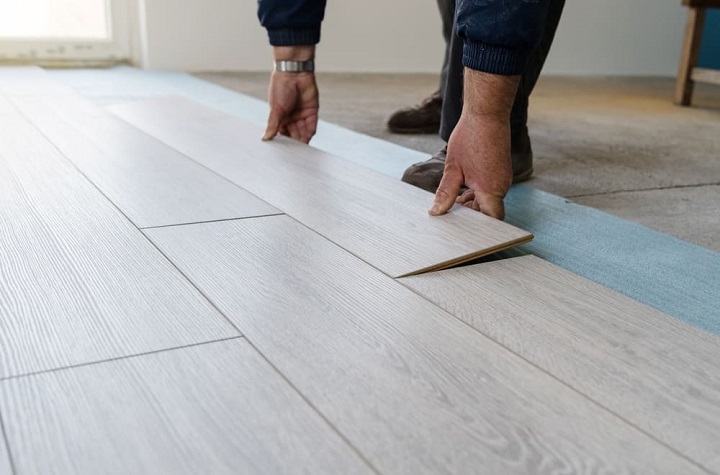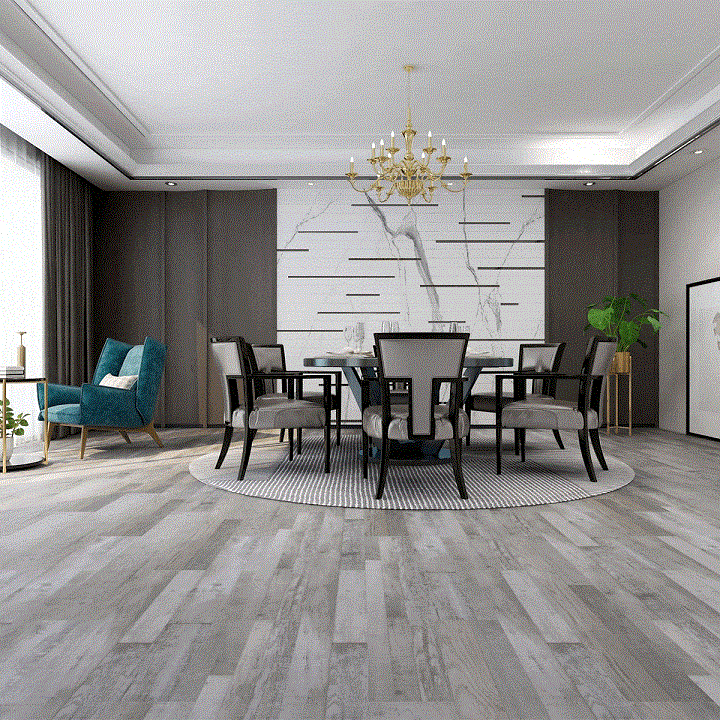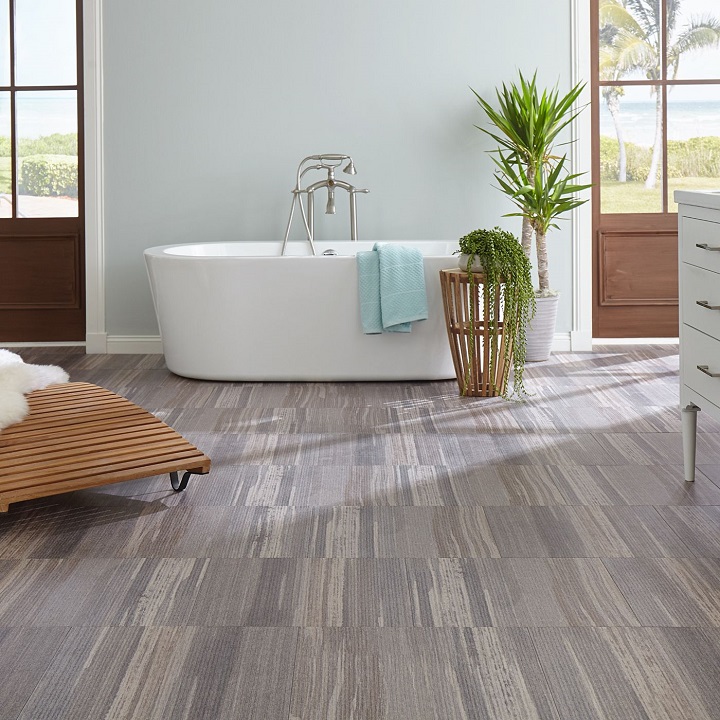What Is Vinyl Flooring?
Floor vinyl has been a long-time favourite among homeowners. It first appeared in the 1950s, became better known in the 1970s and it has been gaining popularity and evolving ever since. Being incredibly hard-wearing, it’s perfect for any room in the house that has heavy foot traffic. It has many benefits such as being waterproof and water-resistant, simple to maintain, highly durable, easy to install and fits every decor.
How Is Vinyl Flooring Made?

A lot of people confuse vinyl with laminate or linoleum flooring but they are actually very different materials. The base for vinyl flooring is polyvinyl chloride, commonly known as PVC. It is first suspended in a liquid and a spreading mixture is created. This mixture includes plasticizers, pigments and trace stabilizers and a carrier sheet. This liquid is dried and formed into sheets that are cut to a suitable size.
Since nowadays everyone is trying to be eco-friendly and save the environment, premium floor vinyl manufacturers try to use materials that are recyclable or already recycled. The manufacturing process changes by the day as they discover new ways to produce vinyl.
Types of Vinyl Flooring
- There are three types of vinyl floor:
- Luxury Vinyl Planks (LVP)
- Luxury Vinyl Tile (LVT)
- Sheet Vinyl
Luxury floor vinyl planks are long and narrow. They are created with a design layer to mimic wood and are thicker than other vinyl floors which makes them more durable and more resistant to scratches. This design can feature an array of colours and textures to accommodate the existing trends, from light brown to greyish and even white tones. Sometimes, additional layers can be added to strengthen the design. The first option to install LVP is by tongue-and-groove. This allows an easy installation and creates a waterproof surface suitable for rooms like kitchens, basements and bathrooms. The second option is glue-down installation. This provides more stability and durability, especially in bigger rooms.
Luxury vinyl tile is designed to mimic stone, ceramic tile or porcelain. It is also thicker than sheet vinyl and the natural designs create realistic visuals. This type of flooring is great for families that have children and pets because there will be no worries about spillage and messes, all you need to do is wipe and go. Its durability and waterproof are allowing you to do that. LVT can be installed over the existing flooring so you don’t have to bother and rip the old flooring.
Among the three, sheet vinyl is the cheapest and easiest to install. It is quite budget-friendly and a bit thinner than the previous two which makes it more susceptible to scratches and damages. It comes with different designs that will suit your needs and trends and it’s easily replaceable when you get tired of the same pattern, colour and design.
Benefits of Vinyl Flooring

Now that we’ve seen what vinyl flooring is and how it’s made, let’s take a look at its advantages.
Affordable
When compared to wood, stone or ceramic vinyl flooring has been, and still is, one of the most affordable options there are. Sometimes the prices of other materials can go up to 10 times more than the ones of vinyl, plus when you add the costs for initialization it can be very expensive and cut your budget very low. With its easy instalment, vinyl can be an easy DIY project for you and your family. Prices can vary depending on the thickness, brand and pattern you choose, but the options are vast and affordable.
Water-Resistant
As we said before vinyl is a great waterproof and water-resistant material. These features make it suitable for rooms that are high in moisture and at risk of spillages such as kitchens, bathrooms, laundry rooms and basements. Accidental spills and messes from your pet won’t be a problem anymore. Just a simple swipe will do the trick. With this, you can have “wood” flooring in places you never imagined you’d have.
Design Options
Probably one of the biggest benefits of vinyl flooring is its appearance. It can take so many colours, textures, designs and patterns and fit into almost every home and style. Its print can be stone, tile and even wood grain patterns and so realistic that many people can’t tell the difference between the real thing and vinyl. This makes it a great option to replace something that is expensive, and still look like it is.
Easy to Clean and Maintain

Same as any type of flooring, vinyl also needs to be cleaned on occasions. It is very easy to clean and maintain, but this doesn’t mean you should neglect it, especially if it’s in a high traffic area. First, it should be cleaned with a vacuum, broom or microfiber sweeper to get rid of the dirt and debris to avoid scratches and damages. After that, a wet mop and a mild cleaner will do the trick and take care of any stains. Make sure you don’t use a strong cleaner so it doesn’t damage the surface long-term. Oftentimes, just a vinegar-based cleaning will make do, and keep those floors as new for many years to come.
Potential Downsides
Vinyl has its pros and cons just like any other flooring out there. Let’s take a look at the potential downsides of it.
Hard to Remove
When the planks are glued down to the floor, the glue hardens and this makes the removal very difficult. If you need to replace one plank it can be a problem, the chances of removing just one board to replace it are very slim. Plus, if you want to reapply glue to the same plank sanding the backside is a must and time-consuming. The same goes for tongue-and-groove and snap together planks, hard to remove just one of them, you need to start removing from one side until you get to the desired plank.
Colours Can Fade
If the vinyl flooring is constantly exposed to direct sunlight, then chances are, the design will fade over time. Try to avoid installing it in rooms with this kind of setting, or if you can’t, the only thing to do is coat them with a UV-resistant layer to keep them safe.
Emits VOCs
Vinyl made products are known to emit harmful gases and volatile organic compounds (VOCs). This can have some serious impact on our health, causing headaches, eye itchiness, dizziness or respiratory irritation. Luckily most of the vinyl floorings that are high-quality emit these gases for a week or two so make sure you keep your home ventilated or use air fresheners to reduce the effects.